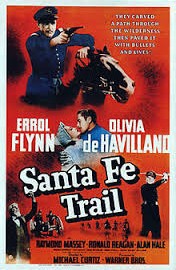Movie Review: Santa Fe Trail
This 1940 production stars Errol Flynn as J.E.B. Stuart, Ronald Reagan as George Armstrong Custer, Raymond Massey as John Brown and Olivia de Havilland as Kit Carson Holliday.
Stuart and Custer, newly graduated from West Point, are assigned to Fort Leavenworth in Kansas. There they battle the rogue abolitionists under the command of Brown, while competing for the hand of Holliday. After Brown’s forces are seemingly smashed, the soldiers are recalled to Washington, and subsequently are involved in the battle of Harper’s Ferry.
It’s actually a good movie given the obvious budget constraints it was under. The actors perform well (especially Massey), and the team of Flynn and de Havilland continues to sell the romance angle as in their previous pictures.
On the other hand, the film is crammed to the brim with both historical inaccuracies and historical revisionism. The trend at the time was to “whitewash” slavery and portray antebellum Southerners sympathetically so as to be able to show your movies in Dixie. Gone With the Wind had come out just the year before.
So it’s the noble and heroic Southerner Stuart and his friends battling the evil abolitionists under the command of religious fanatic Brown (okay, John Brown was a religious fanatic.) The good guys tacitly acknowledge that slavery might possibly not be a good thing, but always follow this with a condemnation of John Brown’s tactics. It’s implied that the Southern states would have given up slavery peacefully in their own good time had the abolitionists not stirred up hatred against them.
John Brown gets to state openly that slavery is wrong, but he’s crazy from years of trying to achieve peaceful change and getting nowhere. And secondary villain Rader, a West Point dropout, seems more driven by class envy and greed than than actual concern for the slaves. His complaint is that Southern gentlemen like Stuart have gotten rich off using slave labor (but doesn’t mention any of the other things that made slavery bad) and he joins Brown’s forces as a mercenary trainer. Rader winds up betraying Brown when he doesn’t get paid.
The abolitionists are portrayed as murderous invaders of Kansas, and a station on the Underground Railroad is referred to as a “cancer” in the title cards. Care is taken to avoid mentioning the atrocities perpetrated by pro-slavery forces in the territory.
The black people in the movie are depicted as childlike, innocent victims of John Brown’s crusade on their behalf. They’re lured in by his promise of freedom, but he has to abandon them to fend for themselves when the cavalry comes, in order to carry on his crusade. Meanwhile, it is Jeb Stuart (a slaveowner in real life) who saves the black family when danger threatens. Two of the rescue-es explicitly reject freedom and decide to return to “safe” slavery, while none are heard to choose to live free.
Again, as a movie it’s pretty good. But it is a product of another time, and those who really care about history and civil rights may find their blood boiling. Also, there’s maybe ten minutes tops spent on the Santa Fe Trail itself.


